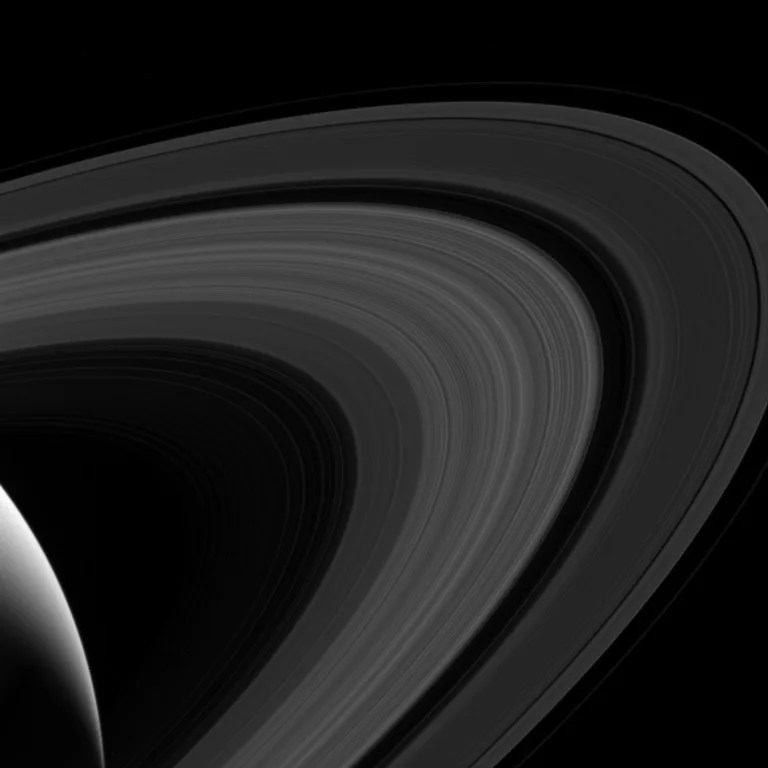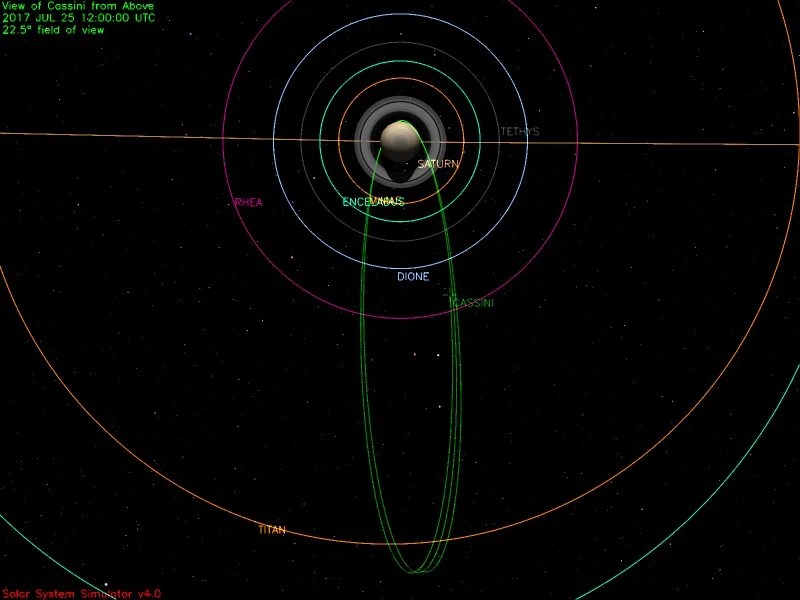7 min read

This week happened to include two of Cassini's periapses, along with their associated close-in passages through Saturn's equatorial ring plane, which occur once every 6.5 days. Each time, Cassini swooped between the innermost D ring and the upper traces of Saturn's atmosphere, flying its nail-biting Grand Finale course with utmost accuracy. An image featured at the top of a news release this week, https://go.nasa.gov/2eIhzpx, offers a sense of what it's like to be in that region, and it gives a clear view of the thin upper haze in which Cassini will soon be burning up like a meteor. The article also covers a few new findings from Cassini, whose "...observations continue to surprise and delight as we squeeze out every last bit of science that we can get," using the spacecraft's remote-sensing telescopes and its suite of direct-sensing, environmental instruments.
Wednesday, July 19 (DOY 200)
Cassini flew through periapsis in its orbit #284 of Saturn today, minutes after crossing the equatorial ring plane going south. This was the 14th time the spacecraft has plunged through the narrow space in between Saturn's rings and atmosphere. The Magnetometer (MAG) had the spacecraft rolling, to best characterize Saturn's magnetic field.
Measurements by MAG are very important during these passages close to Saturn. Among the specifics MAG data addresses are: understanding the amount of departure of Saturn's magnetic field from symmetry with the planet's rotational axis; resolution of the planetary rotation period; the depth of Saturn's dynamo region; the size of the planet's central core; and the strength of field inside the planet. In addition, and in conjunction with other instruments, measurements of field-aligned electric currents lend a better understanding of auroral processes.
During the brief ring-plane crossing shortly after periapsis, the Radio Science Team conducted a ring occultation experiment, in which the ground stations recorded Cassini's continuous radio transmissions as the radio beams passed through the rings. While ground stations of the Deep Space Network (DSN) and the European Space Agency (ESA) tracked Cassini, they continued to measure the spacecraft's small-scale changes in velocity that correspond to variations in the distribution of mass within the gas giant planet and its rings.
After about four and one-half hours, Cassini had swung around behind Saturn far enough that its radio beams again penetrated the rings on their way back to Earth, this time crossing more slowly, providing one last active remote-sensing of the rings.
The Radio Science team will observe Cassini's radio signal while it enters Saturn's atmosphere on its final dive on Sept. 15, but today's experiments were the final dedicated Radio Science experiments for the mission. Many members of the Radio Science team, along with other flight team members, were on hand during the day's activities to pay final respects to a very successful chain of Radio Science observations spanning many years.
Science observations on this day of periapsis finished with the Visible and Infrared Mapping Spectrometer (VIMS) spending 7.7 hours mapping Saturn’s southern night-time hemisphere. The Composite Infrared Spectrometer (CIRS) and the Ultraviolet Imaging Spectrograph (UVIS) rode along.
Thursday, July 20 (DOY 201)
Cassini's Imaging Science Subsystem (ISS) spent 90 minutes observing the atmosphere of Saturn's largest moon, Titan, as part of the weather monitoring campaign, from a distance of 1.9 million kilometers; VIMS rode along.
Next, UVIS began a five-hour series of observations. It included two stellar occultations using background stars in the constellation Orion as they passed behind Saturn's upper atmosphere, surveying temperatures and chemical species in the thermosphere. Also included were UVIS observations of Saturn's southern auroral zones, with CIRS and VIMS, and ISS as riders.
Following these activities, while Cassini was on its way out towards apoapsis, it had coasted near the orbit of Titan, though still south of the ring plane. From this vantage, CIRS began a 10-hour observation creating a far-infrared map of Saturn; VIMS rode along. Their view was toward the enormous planet's night side, as illustrated here.
Friday, July 21 (DOY 202)
UVIS watched three more stellar occultations by Saturn’s atmosphere today, each about an hour long. In between these, VIMS studied Saturn for a total of nearly six hours with CIRS riding along, and ISS monitored Titan's weather once again for 90 minutes; the planet-like moon was at a distance of 1.9 million km. Finally today, ISS made a two-hour observation of the bright sunlit crescent along Saturn's northern limb, with UVIS and VIMS riding.
Saturday, July 22 (DOY 203)
VIMS spent 3.2 hours making a mosaic covering Saturn's northern hemisphere, with CIRS and ISS riding along. Later, Cassini coasted through apoapsis, marking the start of its Orbit #285. Next came another 90-minute ISS Titan weather observation, with CIRS and VIMS riding. Then, while MAG had the spacecraft rotate about its lateral axis for an 11.7-hour calibration, UVIS scanned the sky, surveying the abundance of hydrogen in interplanetary space.
Sunday, July 23 (DOY 204)
UVIS held the reins for 14.7 hours today to observe Saturn's northern auroral area; CIRS rode along.
Monday, July 24 (DOY 205)
Early in the day UVIS observed a stellar occultation, as an ultraviolet-bright star in Orion emerged from behind Saturn's sunlit northern limb. Later, ISS watched Titan's weather again for 90 minutes from a distance of one million km, while VIMS rode along. Finally, while the spacecraft was gaining speed toward its next periapsis passage, UVIS began nearly 12 hours of observing Saturn's sunlit northern auroral zone, with CIRS riding along.
An image of Saturn's rings, taken before the F-ring and Proximal orbits began, is featured today: /resources/17711.
Tuesday, July 25 (DOY 206)
Cassini made its 15th plunge through the ring plane between Saturn and its rings. Periapsis passage followed five minutes later. Before and after periapsis, the Radio and Plasma Wave Science instrument was listening for evidence of lightning "whistlers" coming from Saturn (these are discussed in an article here: https://go.nasa.gov/2uCIVBb). If whistlers are actually detected, they would verify the existence of lightning, which is already suspected, and would provide information about the electron density along the magnetic field line to the source.
Magnetic field observations were of prime importance during closest approach. During the period, the spacecraft performed several relatively rapid turns, using its small rocket thrusters, to calibrate MAG for its high-intensity magnetic field observations.
The DSN communicated with and tracked Cassini on 10 occasions this week, using stations in California, Spain, and Australia. The European Space Agency also contributed ground antenna support on one occasion from Australia. A total of 10 individual commands were uplinked, and about 1,260 megabytes of science and engineering telemetry data were downlinked and captured at rates as high as 142,201 bits per second.
Wrap up:
Cassini is executing its set of 22 Grand Finale Proximal orbits, which have a period of 6.5 days, in a plane inclined 61.9 degrees from the planet's equatorial plane. Each orbit stretches out to an apoapsis altitude of about 1,272,000 km from Saturn, where the spacecraft's planet-relative speed is around 6,000 km/hr. At periapsis, the distance shrinks to about 2,500 km above Saturn's visible atmosphere (for reference, Saturn is about 120,660 km in diameter), and the speed is around 123,000 km/hr.
The most recent spacecraft tracking and telemetry data were obtained on July 26 using the 70-meter diameter DSN station in Australia. The spacecraft continues to be in an excellent state of health with all of its subsystems operating normally except for the instrument issues described at https://saturn.jpl.nasa.gov/anomalies.
The countdown clock in Mission Control shows 51 days until the end of the Mission.
------------------------
This page offers all the details of the Mission's ending: <https://saturn.jpl.nasa.gov/mission/grand-finale/overview/>
------------------------
Milestones spanning the whole orbital tour are listed here:
<https://saturn.jpl.nasa.gov/mission/saturn-tour/tour-dates/>
------------------------
Information on the present position and speed of the Cassini spacecraft may be found on the "Present Position" page at:
<https://saturn.jpl.nasa.gov/mission/saturn-tour/where-is-cassini-now/>
------------------------
To unsubscribe from Cassini Spacecraft Updates or to subscribe with a different email address, visit:
<http://saturn.jpl.nasa.gov/news/mailinglistsignup/>
------------------------
For comments and questions, please contact Cassini Public Engagement at:
<http://saturn.jpl.nasa.gov/feedback/>
------------------------








